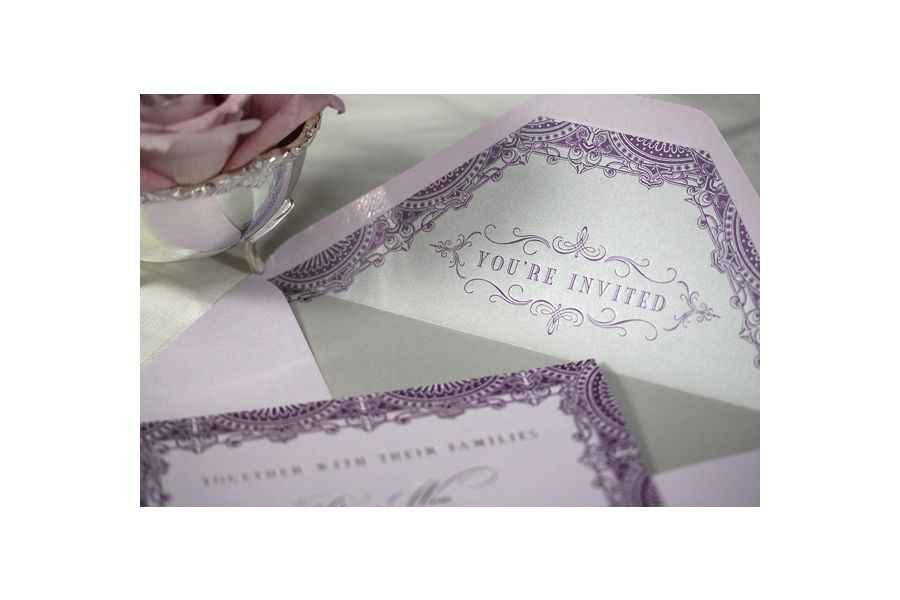All You'll Ever Need to Know About Wording Your Wedding Invitations

Whether you’re having your wedding invitations letterpressed or making them yourself, most modern brides could benefit from a little education on wording etiquette. “The most important thing is that you feel comfortable with your invitation, because there really is an option for everybody,” says Anna Post, etiquette expert and author of “Do I Have To Wear White?: Emily Post Answers America’s Top Wedding Questions” (Collins Living, 2009). But first it helps to understand the basics, so here are Post’s tips for achieving the perfect formal invitation.
The Classic Formal Invitation
The formal invitation begins with the names of the hosts, typically the bride’s parents – i.e. the people paying or the wedding. However, there are multiple variations that account for divorced parents, step-parents and the various scenarios regarding who’s footing the bill. For more in-depth information about wording complex situations, thumb through the fifth edition of “Emily Post’s Wedding Etiquette” (William Morrow, 2005) by Peggy Post.
Invite Intricacies
• Although you use the abbreviation Mr., always spell out the word “Doctor” if it is part of a title.
• If the event is taking place in a house of worship, you say “request the honour of your presence.” If the event is anywhere else, you say “request the pleasure of your company.”
• Honour is spelled with a “u”
• Names are always on their own line
• Christian wedding invitations typically use the word “to” between the names of the bride and groom, while Jewish invitations usually use “and.”
• Include only the bride’s full first and middle name.
• Include Mr. before the groom’s full first, middle and last name
• Spell out the entire day and month
• The year is spelled out on its own line, without using the word “and” between century and decade or year.
• Spell out the time, but you should use “half-after” instead of “half-past.”
• Include the name of the church or property where the ceremony will take place.
• Include the full name of the town and state, but do not include the address; for Washington D.C., skip the name of the town and write out District of Columbia.
• Left-justified at the bottom of the invitation, include simply “RSVP” with en dash between the letters or contact information that follow.
• Never include registry information on the invite.
• There is no mention of attire, as the formality of the affair is dictated by the style of the invitation, the time of day and the location
RSVP Card
Once upon a time, guests who received a wedding invitation would know to write their own timely reply in formal language on personal stationary. These days we include reply cards. It’s even OK to save money and trees by using an RSVP postcard, says Post. However, although modern times certainly allow for variation in the RSVP wording, she advises against providing boxes that allow invitees to write in the number of guests – your cousin Joe might view this as an open invitation to bring along his three favorite frat buddies.
The Write Way To Do RSVP Cards
The classic format for RSVP cards looks something like this:
M_____________________
___ accept(s) with pleasure
___ decline(s) with regret
The favour of a reply is requested by the 27th of June
Name and Checkmark Lines
• The respondent fills in the names of all invited guests, starting with a Mr. or Ms.
• Include the (s) to accommodate both single and multiple invitees
• Less formal option: Simply include accept(s) and decline(s), without the pleasure or regret
The Favour/Date Line
• This information is usually all one line
• It can be above or below the name and checkmark lines, but is usually below
• No need to spell out the date
• Favour is spelled with a “u”
• The year is not included here, unless there is a change in years between the sending of the invite (e.g. December 2009) and the wedding (e.g. January 2010)
• It is OK both to use a period, or to go without
• Less formal option: Simply say “Please reply by the 27th of June”
The RSVP Envelope
Always self-address and stamp the RSVP envelope. It should be addressed to whomever sent out the invitations and is handling the guest list.
Invitation Envelope
Formal invitations have typically included both an outer and an inner envelope. For a family of five, the outer envelope would be addressed to Mr. and Mrs. John Smith. The inner envelope would repeat these names, as well as list any other family members at this address who are included e.g. the names of all three kids, or just the name of the oldest child if you are, say, only including children over a certain age. You may also say “The Smith Family” to include everyone. If you are inviting a friend who is dating someone who lives at a different address, either send each person their own invitation, or write only the name of the friend on the outer envelope, and then your friend’s name and “plus guest” on the inner envelope.
These days, however, more people are using just one envelope, says Post. It is less formal, but in these instances, you must include the name of every invitee, as well as the “plus guest,” above the address.
Enclosures
Ideally you will limit your enclosures to one sheet, says Post. Only include pertinent details, such as directions and information about hotel blocks and possibly airports if there are multiple options or the location is difficult to reach. You also may include your Web site URL (save space by noting that guests can find the rest of the info on your Web site), but never include gift information in the enclosures, not even to say “No gifts, please,” says Post.
[Photo: Minna Designs]
© Brides 365